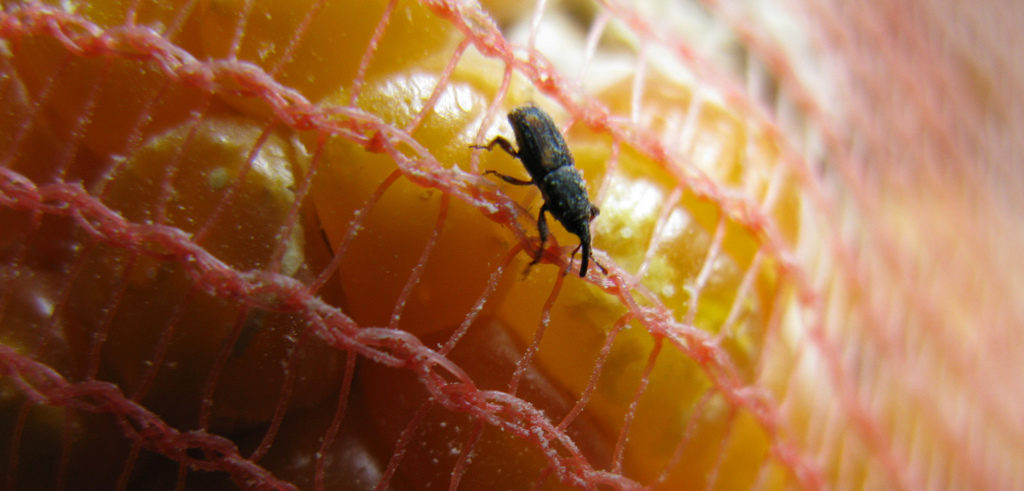Substantial pre- and post-harvest losses occur as a result of inefficiencies of the agricultural value chain. Reducing losses caused by pest destruction, inefficient storage, and crop contamination would directly contribute to greater food security. One of the sessions at the Agri4D Conference was devoted to this particular issue. The session featured four speakers who each offered insights into the subject of pre- and post- harvest losses and provided specific examples from their own research.
Adam John, PhD candidate, University Putra Malaysia, Kuala Lumpur, presented on “Rodent outbreaks in Southeast Asian rice cropping systems: using ecologically based rodent management to reduce pre-harvest losses”. According to his research, in South East Asia, 10-15% of pre-harvest losses of rice crops are caused by rodents; these losses are equivalent to 15% of a farmer’s income.
Ecologically based rodent management (EBRM) uses ecological knowledge and traditional forms of management to reduce the use of rodenticides. For example, trap barrier systems involve the planting of an early rice crop to attract rodents. Traps are then placed at all entrances of the paddy to catch rodents before the primary crop is planted. Adam John’s findings state that the use of EBRM has reduced yield losses by up to half and also reduced the use of rodenticides.
The next presentation, by Dr. Cornel Adler from the Julius Kühn-Institut, Berlin, was devoted to post-harvest losses, i.e. “Stored product protection research in Germany with a focus on tropical agriculture and cooperation”. Dr Adler specifically advocates for an Integrated Stored Product Protection system where methods of pest prevention, early pest detection and pest control are used in combination to achieve secure storage. For example, phytochemicals are used as aromatic or pheromone attractants to lure and trap pests. Preventative pest control is essential for the protection of the stored product.
Johanna Lindahl, Post doctoral Researcher, International Livestock Research Institute (ILRI), Nairobi, presented her research about “Aflatoxins as major contributions to harvest loss – what do we know and not know?” Her research examines the susceptibility of products, during all stages of agricultural production, to contamination with mycotoxin-producing fungi. It is an invisible, odourless and heat-stable toxin that results in loss of safe products. Most importantly, it is a great threat to human health as it is one of the most potent carcinogens known. Chronic exposure to aflatoxins can cause carcinogenic-hepatocellular carcinoma, stunting, and decreased immune defense. According to the US CDC an estimated 4.5 billion people are chronically exposed and an outbreak can potentially cause 100 fatalities. Johanna Lindahl’s findings reveal that genetically modified maize as well as products such as Aflasafe, can be possible solutions to reducing aflatoxins. The biocompetetive product Aflasafe is atoxigenic strains developed by microbiologists. These strains cannot produce aflatoxins and cannot become toxigenic. Read more…
Professor Bina Agarwal, University of Manchester, reiterated the points made by the three presenters and offered some conclusions from the session. There is a clear consensus among the speakers that pre- and post- harvest losses as a result of rodents, pests, fungi etc. is a serious threat to food production in both developed and developing countries. Ineffective forms of management, bad infrastructure, and poor storage systems lead to crop and quality losses as well as massive amounts of waste. Specifically, she emphasized the importance of cooperation between stakeholders as a way forward.
The central theme of the discussion that ensued was the separation of the debate regarding food versus fuel. Much of the harvest losses that exist can, in fact, be valuable to the agricultural supply chain. Waste from crop losses can be employed for a multitude of uses, including value-added products, food-crop residues etc. It was suggested that the ongoing antagonism between food and fuel should be brought together to create a more holistic discussion.
Climatic volatility, such as increasing temperatures and rainfall, was also pointed out as a potential threat to the acceleration of the development of pests. Adam John emphasized the impact of increased rainfall which leads to greater abundances of harvests open to pests. Similarly, Cornel Adler added that hot climate speeds up the growth of insects, leading to major losses. Elements of climate change such as weather volatility and increased temperature will increase the threat of pests and, therefore, are central to any discussion on harvest losses.
Furthermore, it was emphasized that successful adaption and management strategies need to be focused on local systems and incorporate community-based action. Bina Agarwal highlighted the success of local “master farmers” in India that work to link research with practice. Similarly, solutions must link new innovations and technologies with local farmers. It was suggested that genetically modified products should be examined as a possibility to reduce susceptibility to pests. However, even though these products have proven to be useful, they are rarely affordable. Technologies need to be made more available to farmers.
Finally, the weak communication between research and farmers on the ground was discussed. It was suggested that extension systems/services are needed; for example, connection to local leaders or cooperatives could assist in creating linkages between farmers and regional organizations. Another recommendation was that better cross sector cooperation is needed in order to use the existing technologies at full capacity.
Rapporteur: Kristin Follis
